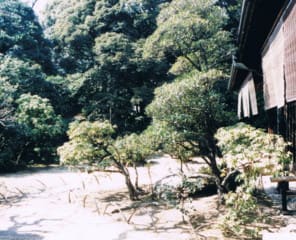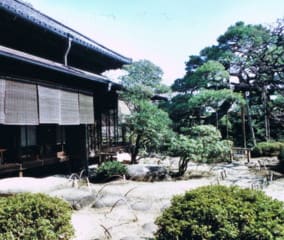千葉県野田市。野田と言えば醤油です。全国生産量の約5分の1を醸造する醤油の町。市内はキッコーマンの企業城下町と言われているとか。
向かう先は「上花輪歴史館」。野田醤油を始めた上花輪の名主・旧高梨邸で、平成13年に「高梨氏庭園」として、千葉県では初めて、国の名勝に指定されました。
東武野田線の「野田市駅」から徒歩15分。突き当たった築地塀に沿って歩いて行くと、立派な「冠木門」があり、そこを入ると、その先には、これまた豪壮な「門長屋」。その先に待つ約1万平方メートルの敷地に、入口から早くも期待感が高まる門構えです。

(上: 旧家の格式を伝える冠木門。奥に門長屋が見える)

(上: 豪壮な門長屋)
古くからこの「上花輪」の地に居住し、名主をつとめていたという高梨家が、醤油と関わるのは、寛文元年(1661)、十九代高梨兵左衛門の時です。
その後、天明元年(1781)には、近隣の七醸造家で野田醤油仲間を結成、翌年には「亀甲万印」の醤油醸造を始め、江戸川の船運を利用して、大消費地の江戸へ短時間で送ることができるという地の利を生かしながら、飛躍的に発展していったということです。
現キッコーマンは、大正6年に、市内の茂木家と高梨家が中心となって起こした野田醤油株式会社が前身となっています。
門をくぐると、砂利敷きのアプローチの脇に石燈籠、マツ、石組、クマザサなどでまとめられた築山のある、すっきりした前庭。表玄関の背後に見える小山のような樹林が印象的です。

(上: 門長屋と表玄関をつなぐ端正な前庭)
そこから左手の築地塀の向こう側に出ると、明るい空間が広がり、稲荷神社や醸造の神様「松尾大社」の社(やしろ)、神楽殿が点在。中に薬草園もあります。その後ろは茶室・眺春庵。

(上: 茶室・眺春庵)
屋敷林で囲まれた裏手には、湧水を水源とした「構堀(かまえぼり)」と船着き場があります。家人が江戸に出る時に使用されたものです。
「構堀(かまえぼり)」から住居の方に回ると書院。書院前の庭の主木はカシワ。足元はツツジなどの刈込みを縫うように、飛石を配し、北側のタブの林を山に見立てているのが特徴的です。これは「北に山、西に森」という風水思想に基づいたものということ。


(上: 小山のような屋敷林)
園路はさらに続き、枝振りの見事なマツの脇を通り、渡り廊下の下をくぐって向う側に出ます。そこには由緒ある茶室の名を借りた残月亭という客間と、寒雲亭と呼ばれる若夫婦用の居室が並び建ち、風雅な佇まいを見せています。

(上: 枝振りの良い木が景色を創っている高梨家書院前の庭)
ここを訪れたのは何年か前のことで、室内の見学はできませんでしたが(現在は条件付で可)、覗き込むと、それぞれの建物の内部には、もてなし用の膳が並んでいたり、人形が飾られていたり、仕立物が広げられていたりと、今でもそこで暮らしが営まれているような設えがされていて、温かみを感じます。
豪商の暮らしに密着した建物と庭園は、代々の当主の好みによってつくられたもの。建築物でもっとも古いのは「門長屋」で、明和3年(1766)築。書院は文化3年(1806)築など、江戸時代から明治、昭和初期と、各時代の建物が、手入れの行き届いた趣ある庭園の中に、調和よく軒を連ねているのが心地良いことでした。
# 詳しい利用案内については、「上花輪歴史館」のホームページなどをご参照ください。 kamihanawa.jp/























